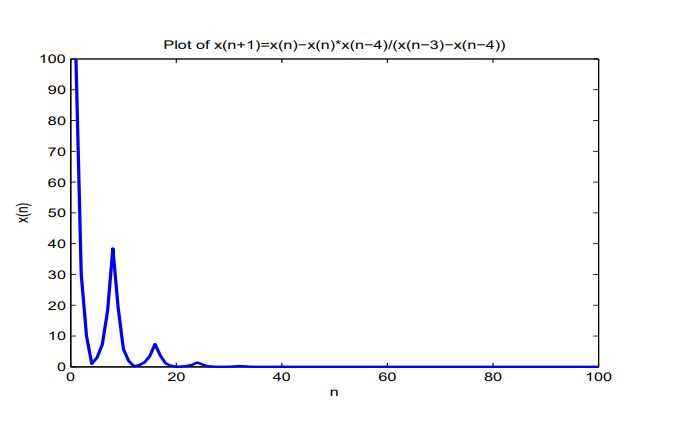In this article, we study some properties of the solutions of the following difference equation: \(x_{n+1}=a x_{n}+\dfrac{b x_{n} x_{n-4}}{cx_{n-3}+dx_{n-4}},\quad n=0,1,…\) where the initial conditions \(x_{-4},x_{-3}, x_{-2}, x_{-1}, x_0\) are arbitrary positive real numbers and \(a, b, c, d\) are positive constants. Also, we give specific form of the solutions of four special cases of this equation.
Our aim in this paper is to investigate the behavior of the solution of the following nonlinear difference equation
Recently there has been a great interest in studying the qualitative properties of rational difference equations. Some prototypes for the development of the basic theory of the global behavior of nonlinear difference equations of order greater than one come from the results for rational difference equations [1, 2, 3, 4, 5, 6, 7, 8, 9, 10, 11, 12, 13, 14, 15].
However, there have not been any effective general methods to deal with the global behavior of rational difference equations of order greater than one so far. From the known work, one can see that it is extremely difficult to understand thoroughly the global behaviors of solutions of rational difference equations although they have simple forms (or expressions). One can refer to [16, 17, 18, 19, 20, 21, 2, 23, 24, 25, 26, 27, 28, 29, 30, 31, 32, 33, 34, 35, 36, 37, 38, 39, 40, 41, 42, 43, 44, 45, 46, 47] for examples to illustrate this. Therefore, the study of rational difference equations of order greater than one is worth further consideration.
Many researchers have investigated the behavior of the solution of difference equations, for example,
Elsayed et al. [37] has obtained results concerning the dynamics and global attractivity of the rational difference equation \begin{equation*} x_{n+1}=\dfrac{ax_nx_{n-2}}{bx_{n-2}+cx_{n-3}}. \end{equation*} Aloqeili [18] has obtained the solutions of the difference equation \begin{equation*} x_{n+1}=\dfrac{x_{n-1}}{a-x_{n}x_{n-1}}. \end{equation*} Simsek et al. [43] obtained the solution of the difference equation \begin{equation*} x_{n+1}=\dfrac{x_{n-3}}{1+ x_{n-1}} \end{equation*} Cinar [22, 23, 24] got the solutions of the following difference equations \begin{equation*} x_{n+1}=\dfrac{x_{n-1}}{1+ax_{n}x_{n-1}}, x_{n+1}=\dfrac{x_{n-1}}{ -1+ax_{n}x_{n-1}}, x_{n+1}=\dfrac{ax_{n-1}}{1+bx_{n}x_{n-1}}. \end{equation*} In [48], Ibrahim got the form of the solution of the rational difference equation \begin{equation*} x_{n+1}=\dfrac{x_nx_{n-2}}{x_{n-1}(a+bx_{n}x_{n-2})}. \end{equation*} Karatas et al. [46] got the solution of the difference equation \begin{equation*} x_{n+1}=\dfrac{x_{n-5}}{1+x_{n-2}x_{n-5}}. \end{equation*} Here, we recall some notations and results which will be useful in our investigation. Let \(I\) be some interval of real numbers and let \begin{equation*} f : I^{k+1} \rightarrow I, \end{equation*} be a continuously differentiable function. Then for every set of initial conditions \(x_{-k}, x_{-k+1}, x_{-k+2}, …, x_{0} \in I\), the difference equationDefinition 1. A point \(\bar x \in I\) is called an \textit{equilibrium point} of Equation (2) if \(\bar x=f(\bar x,\bar x,…,\bar x)\). That is, \(x_n = \bar x\) for \(n \geq 0\), is a solution of Equation (2), or equivalently, \(\bar x\) is a fixed point of \(f\).
Definition 2.
Theorem 3. Assume that \(p, q \in \mathbb{R}\) and \(k \in \{0, 1, 2, …\}\). Then \(|p| + |q| < 1\) is a sufficient condition for the asymptotic stability of the difference equation \begin{equation*} x_{n+1} + px_n + qx_{n-k} = 0, n = 0, 1, \ldots \end{equation*}
Remark 1. The theorem can be easily extended to a general linear equations of the form
Theorem 4. Let \([a, b]\) be an interval of real numbers and assume that \begin{equation*} g:[a, b]^3\rightarrow [a, b], \end{equation*} is a continuous function satisfying the following properties:
In this section we investigate the local stability character of the
solutions of Equation (1). Equation (1) has a unique equilibrium point
and is given by $$\bar x=a \bar x+\dfrac{b
\bar x^2}{ c \bar x+d \bar x},$$ or x̄2(1 − a)(c + d) = bx̄2,
then if (1 − a)(c + d) ≠ b
, then the unique equilibrium point is x̄ = 0.
Define the following function $$\begin{array}{llll} f:(0,\infty)^3\rightarrow
(0,\infty) & & & \\ f(u,v,w)=a u+\dfrac{b u w}{c v+d w}.
& & & \end{array}$$ It follows that $$f_u(u,v,w)=a +\dfrac{b w}{c v+d w}, \quad
f_v(u,v,w)=-\dfrac{bc u w}{(c v+d w)^2},\quad f_w(u,v,w)=\dfrac{b cu
v}{(c v+d w)^2}.$$ Then $$f_u(\bar
x,\bar x, \bar x)=a +\dfrac{b }{c +d}, \quad f_v(\bar x,\bar x, \bar
x)=-\dfrac{bc}{(c +d )^2},\quad f_w(\bar x,\bar x, \bar x)=\dfrac{bc}{
(c +d )^2}.$$ The linearized equation of Equation (1) about x̄ is complete.</p>
Theorem 5. Assume that \begin{equation*} b(d+3c)< (1-a)(c+d)^2. \end{equation*} Then the equilibrium point of Equation (1) is locally asymptotically stable.
Proof. It follows from Theorem 3 that Equation (5) is asymptotically stable if \begin{equation*} \left|a +\dfrac{b }{c +d}\right|+\left|\dfrac{bc}{(c +d )^2}\right|+\left| \dfrac{bc}{(c +d )^2}\right|< 1, \end{equation*} or \begin{equation*} a +\dfrac{b }{c +d}+\dfrac{2bc}{(c +d )^2}< 1, \end{equation*} and so, \begin{equation*} \dfrac{b(d+3c) }{(c +d )^2}< (1-a). \end{equation*} The proof is complete.
Theorem 6. The equilibrium point \(\bar x\) of Equation (1) is global attractor if \(d(1-a)\not=b\)
Proof. Let \(p,q\) be real numbers and assume that \(g:[p, q]^3\rightarrow [p, q]\) is a function defined by \( g(u,v,w)=au+\dfrac{buw}{cv +dw}\), then we can easily see that the function \( g(u,v,w)\) is increasing in \(u,w\) and decreasing in \(v\). Suppose that \((m,M)\) is a solution of the system \begin{equation*} M=g(M,m,M),\qquad m=g(m,M,m). \end{equation*} Then from Equation (1), we see that \begin{equation*} M=aM+\dfrac{bM^2}{cm +dM},\qquad m=am+\dfrac{bm^2}{cM +dm} \end{equation*} or \begin{equation*} M(1-a)=\dfrac{bM^2}{cm +dM},\qquad m(1-a)=\dfrac{bm^2}{cM +dm} \end{equation*} then \begin{equation*} c(1-a)mM+d(1-a)M^2=bM^2,\qquad c(1-a)mM+d(1-a)m^2=bm^2 \end{equation*} subtracting, we obtain \begin{equation*} d(1-a)(M^2-m^2)=b(M^2-m^2). \end{equation*} Since \(d(1-a)\not=b\) therefore \begin{equation*} M=m. \end{equation*} It follows from Theorem 4 that \(\bar x\) is a global attractor of Equation (1), and then the proof is complete.
Theorem 7. Every solution of Equation (1) is bounded if \(a+\dfrac{b}{d}< 1\).
Proof. Let \(\{x_n\}_{n=-4}^\infty\) be a solution of Equation (1). It follows from Equation (1) that \begin{equation*} x_{n+1}=a x_{n}+\dfrac{b x_{n} x_{n-4}}{c x_{n-3}+dx_{n-4}}\leq a x_{n}+ \dfrac{b x_{n} x_{n-4}}{dx_{n-4}}=\left(a+\dfrac{b}{d}\right)x_{n}. \end{equation*} Then \(x_{n+1}\leq x_{n}, \quad \forall n\geq 0\). Then the sequence \( \{x_n\}_{n=-4}^\infty\) is decreasing and so is bounded from above by \( M=\max\{x_{-4}, x_{-3}, x_{-2}, x_{-1}, x_0\}\).
For explaining the results of this section, we consider numerical example for \(x_{-4}=10, x_{-3}=1, x_{-2}=3, x_{-1}=2, x_0=7\). (See Figure 1). \begin{center}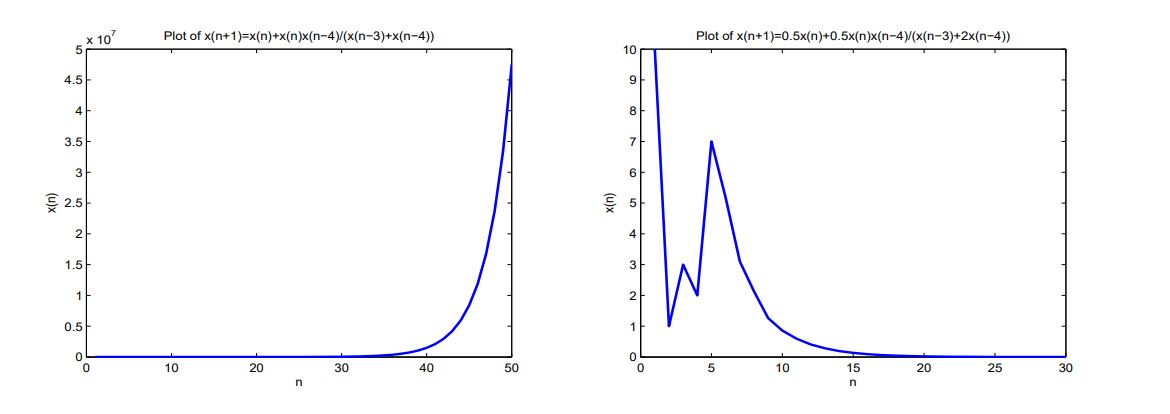
Theorem 8. Let \(\{x_n\}_{n=-4}^\infty\) be a solution of Equation (6). Then for \(n=0,1,2,…\) \begin{equation*} \left\{ \begin{array}{llll} \displaystyle x_{4n}=r\prod_{i=1}^{n}\dfrac{(A_if+2B_ie)}{(B_if+A_ie)} \dfrac{(A_ig+2B_if)}{(B_ig+A_if)}\dfrac{(A_ih+2B_ig)}{(B_ih+A_ig)} \dfrac{ (A_ir+2B_ih)}{(B_ir+A_ih)} , & & & \\ \displaystyle x_{4n+1}=r\prod_{i=1}^{n+1}\dfrac{(A_if+2B_ie)}{(B_if+A_ie)} \prod_{i=1}^{n}\dfrac{(A_ig+2B_if)}{(B_ig+A_if)}\dfrac{(A_ih+2B_ig)}{ (B_ih+A_ig)}\dfrac{(A_ir+2B_ih)}{(B_ir+A_ih)}, & & & \\ \displaystyle x_{4n+2}=r\prod_{i=1}^{n+1}\dfrac{(A_if+2B_ie)}{(B_if+A_ie)} \dfrac{(A_ig+2B_if)}{(B_ig+A_if)} \prod_{i=1}^{n}\dfrac{(A_ih+2B_ig)}{ (B_ih+A_ig)}\dfrac{(A_ir+2B_ih)}{(B_ir+A_ih)}, & & & \\ \displaystyle x_{4n+3}=r\prod_{i=1}^{n+1}\dfrac{(A_if+2B_ie)}{(B_if+A_ie)} \dfrac{(A_ig+2B_if)}{(B_ig+A_if)}\dfrac{(A_ih+2B_ig)}{(B_ih+A_ig)} \prod_{i=1}^{n}\dfrac{(A_ir+2B_ih)}{(B_ir+A_ih)} , & & & \end{array} \right. \end{equation*} where \(x_{-4}=e, x_{-3}=f, x_{-2}=g, x_{-1}=h, x_0=r\), \(\{A_m\}_{m=1}^ \infty=\{1,3,7,17,41,…\}\), \(\{B_m\}_{m=1}^\infty=\{1,2,5,12,29,…\}\) \( A_m=2A_{m-1}+A_{m-2}, B_m=2B_{m-1}+B_{m-2}, m\geq 1, A_{-1}=-1\), \(A_0=1\), \( B_{-1}=1, B_0=0\), or also \(A_m=2B_{m-1}+A_{m-1}, B_m=B_{m-1}+A_{m-1}, m\geq 0 \), and \(\displaystyle \prod_{i=1}^{0}G_i=1\).
Proof. For \(n=0\), the result holds. Now suppose that our assumption holds for \(n-1\) and for \(n-2\). That is \begin{equation*} \left\{ \begin{array}{llll} \displaystyle x_{4n-8}=r\prod_{i=1}^{n-2}\dfrac{(A_if+2B_ie)}{(B_if+A_ie)} \dfrac{(A_ig+2B_if)}{(B_ig+A_if)}\dfrac{(A_ih+2B_ig)}{(B_ih+A_ig)} \dfrac{ (A_ir+2B_ih)}{(B_ir+A_ih)} , & & & \\ \displaystyle x_{4n-7}=r\prod_{i=1}^{n-1}\dfrac{(A_if+2B_ie)}{(B_if+A_ie)} \prod_{i=1}^{n-2}\dfrac{(A_ig+2B_if)}{(B_ig+A_if)}\dfrac{(A_ih+2B_ig)}{ (B_ih+A_ig)}\dfrac{(A_ir+2B_ih)}{(B_ir+A_ih)}, & & & \\ \displaystyle x_{4n-6}=r\prod_{i=1}^{n-1}\dfrac{(A_if+2B_ie)}{(B_if+A_ie)} \dfrac{(A_ig+2B_if)}{(B_ig+A_if)} \prod_{i=1}^{n-2}\dfrac{(A_ih+2B_ig)}{ (B_ih+A_ig)}\dfrac{(A_ir+2B_ih)}{(B_ir+A_ih)}, & & & \\ \displaystyle x_{4n-5}=r\prod_{i=1}^{n-1}\dfrac{(A_if+2B_ie)}{(B_if+A_ie)} \dfrac{(A_ig+2B_if)}{(B_ig+A_if)}\dfrac{(A_ih+2B_ig)}{(B_ih+A_ig)} \prod_{i=1}^{n-2}\dfrac{(A_ir+2B_ih)}{(B_ir+A_ih)}, & & & \end{array} \right. \end{equation*} \begin{equation*} \left\{ \begin{array}{llll} \displaystyle x_{4n-4}=r\prod_{i=1}^{n-1}\dfrac{(A_if+2B_ie)}{(B_if+A_ie)} \dfrac{(A_ig+2B_if)}{(B_ig+A_if)}\dfrac{(A_ih+2B_ig)}{(B_ih+A_ig)} \dfrac{ (A_ir+2B_ih)}{(B_ir+A_ih)} , & & & \\ \displaystyle x_{4n-3}=r\prod_{i=1}^{n}\dfrac{(A_if+2B_ie)}{(B_if+A_ie)} \prod_{i=1}^{n-1}\dfrac{(A_ig+2B_if)}{(B_ig+A_if)}\dfrac{(A_ih+2B_ig)}{ (B_ih+A_ig)}\dfrac{(A_ir+2B_ih)}{(B_ir+A_ih)}, & & & \\ \displaystyle x_{4n-2}=r\prod_{i=1}^{n}\dfrac{(A_if+2B_ie)}{(B_if+A_ie)} \dfrac{(A_ig+2B_if)}{(B_ig+A_if)} \prod_{i=1}^{n-1}\dfrac{(A_ih+2B_ig)}{ (B_ih+A_ig)}\dfrac{(A_ir+2B_ih)}{(B_ir+A_ih)}, & & & \\ \displaystyle x_{4n-1}=r\prod_{i=1}^{n}\dfrac{(A_if+2B_ie)}{(B_if+A_ie)} \dfrac{(A_ig+2B_if)}{(B_ig+A_if)}\dfrac{(A_ih+2B_ig)}{(B_ih+A_ig)} \prod_{i=1}^{n-1}\dfrac{(A_ir+2B_ih)}{(B_ir+A_ih)}. & & & \end{array} \right. \end{equation*} Now it follows from Equation (6) that \begin{equation*} \begin{array}{llll} \displaystyle x_{4n} = \displaystyle x_{4n-1}+\dfrac{ x_{4n-1} x_{4n-5}}{ x_{4n-4}+x_{4n-5}}= r\prod_{i=1}^{n}\dfrac{(A_if+2B_ie)}{(B_if+A_ie)}\dfrac{ (A_ig+2B_if)}{(B_ig+A_if)}\dfrac{(A_ih+2B_ig)}{(B_ih+A_ig)} \prod_{i=1}^{n-1} \dfrac{(A_ir+2B_ih)}{(B_ir+A_ih)} \Bigg(1+ & \\ \dfrac{\displaystyle r\prod_{i=1}^{n-1}\dfrac{(A_if+2B_ie)}{ (B_if+A_ie)}\dfrac{(A_ig+2B_if)}{(B_ig+A_if)}\dfrac{(A_ih+2B_ig)}{(B_ih+A_ig) } \prod_{i=1}^{n-2}\dfrac{(A_ir+2B_ih)}{(B_ir+A_ih)}}{\displaystyle r\prod_{i=1}^{n-1}\dfrac{(A_if+2B_ie)}{(B_if+A_ie)} \dfrac{(A_ig+2B_if)}{ (B_ig+A_if)}\dfrac{(A_ih+2B_ig)}{(B_ih+A_ig)} \dfrac{(A_ir+2B_ih)}{ (B_ir+A_ih)} +r\prod_{i=1}^{n-1}\dfrac{(A_if+2B_ie)}{(B_if+A_ie)}\dfrac{ (A_ig+2B_if)}{(B_ig+A_if)}\dfrac{(A_ih+2B_ig)}{(B_ih+A_ig)} \prod_{i=1}^{n-2} \dfrac{(A_ir+2B_ih)}{(B_ir+A_ih)}}\Bigg) & \\ = \displaystyle r\prod_{i=1}^{n}\dfrac{(A_if+2B_ie)}{(B_if+A_ie)}\dfrac{ (A_ig+2B_if)}{(B_ig+A_if)}\dfrac{(A_ih+2B_ig)}{(B_ih+A_ig)} \prod_{i=1}^{n-1} \dfrac{(A_ir+2B_ih)}{(B_ir+A_ih)}\left(1+ \dfrac{1}{\dfrac{ (A_{n-1}r+2B_{n-1}h)}{(B_{n-1}r+A_{n-1}h)} +1}\right) & \\ = \displaystyle r\prod_{i=1}^{n}\dfrac{(A_if+2B_ie)}{(B_if+A_ie)}\dfrac{ (A_ig+2B_if)}{(B_ig+A_if)}\dfrac{(A_ih+2B_ig)}{(B_ih+A_ig)} \prod_{i=1}^{n-1} \dfrac{(A_ir+2B_ih)}{(B_ir+A_ih)}\left(1+ \dfrac{B_{n-1}r+A_{n-1}h}{ (A_{n-1}+B_{n-1})r+(2B_{n-1}+A_{n-1})h} \right) & \\ = \displaystyle r\prod_{i=1}^{n}\dfrac{(A_if+2B_ie)}{(B_if+A_ie)}\dfrac{ (A_ig+2B_if)}{(B_ig+A_if)}\dfrac{(A_ih+2B_ig)}{(B_ih+A_ig)} \prod_{i=1}^{n-1} \dfrac{(A_ir+2B_ih)}{(B_ir+A_ih)}\; \dfrac{ (A_{n-1}+2B_{n-1})r+(2B_{n-1}+2A_{n-1})h}{ (A_{n-1}+B_{n-1})r+(2B_{n-1}+A_{n-1})h} & \\ = \displaystyle r\prod_{i=1}^{n}\dfrac{(A_if+2B_ie)}{(B_if+A_ie)}\dfrac{ (A_ig+2B_if)}{(B_ig+A_if)}\dfrac{(A_ih+2B_ig)}{(B_ih+A_ig)} \prod_{i=1}^{n-1} \dfrac{(A_ir+2B_ih)}{(B_ir+A_ih)}\; \dfrac{A_{n}r+2B_{n}h}{B_{n}r+A_{n}h} & \\ = \displaystyle r\prod_{i=1}^{n}\dfrac{(A_if+2B_ie)}{(B_if+A_ie)}\dfrac{ (A_ig+2B_if)}{(B_ig+A_if)}\dfrac{(A_ih+2B_ig)}{(B_ih+A_ig)} \dfrac{ (A_ir+2B_ih)}{(B_ir+A_ih)}. & \end{array} \end{equation*} Similarly, \begin{equation*} \begin{array}{llll} \displaystyle x_{4n+1} = \displaystyle x_{4n}+\dfrac{ x_{4n} x_{4n-4}}{ x_{4n-3}+x_{4n-4}}= r\prod_{i=1}^{n}\dfrac{(A_if+2B_ie)}{(B_if+A_ie)}\dfrac{ (A_ig+2B_if)}{(B_ig+A_if)}\dfrac{(A_ih+2B_ig)}{(B_ih+A_ig)} \dfrac{ (A_ir+2B_ih)}{(B_ir+A_ih)}\end{array} \end{equation*}} {\small \begin{equation*} \begin{array}{llll} \Bigg(1+ \\ \dfrac{\displaystyle r\prod_{i=1}^{n-1}\dfrac{(A_if+2B_ie)}{ (B_if+A_ie)}\dfrac{(A_ig+2B_if)}{(B_ig+A_if)}\dfrac{(A_ih+2B_ig)}{(B_ih+A_ig) } \dfrac{(A_ir+2B_ih)}{(B_ir+A_ih)}}{\displaystyle r\prod_{i=1}^{n}\dfrac{ (A_if+2B_ie)}{(B_if+A_ie)}\prod_{i=1}^{n-1} \dfrac{(A_ig+2B_if)}{(B_ig+A_if)} \dfrac{(A_ih+2B_ig)}{(B_ih+A_ig)} \dfrac{(A_ir+2B_ih)}{(B_ir+A_ih)} +r\prod_{i=1}^{n-1}\dfrac{(A_if+2B_ie)}{(B_if+A_ie)}\dfrac{(A_ig+2B_if)}{ (B_ig+A_if)}\dfrac{(A_ih+2B_ig)}{(B_ih+A_ig)} \dfrac{(A_ir+2B_ih)}{ (B_ir+A_ih)}}\Bigg) \\ \end{array} \end{equation*} \begin{equation*} \begin{array}{llll} = \displaystyle r\prod_{i=1}^{n}\dfrac{(A_if+2B_ie)}{(B_if+A_ie)}\dfrac{ (A_ig+2B_if)}{(B_ig+A_if)}\dfrac{(A_ih+2B_ig)}{(B_ih+A_ig)} \dfrac{ (A_ir+2B_ih)}{(B_ir+A_ih)}\left(1+ \dfrac{1}{\dfrac{(A_{n}r+2B_{n}h)}{ (B_{n}r+A_{n}h)} +1}\right) \\ = \displaystyle r\prod_{i=1}^{n}\dfrac{(A_if+2B_ie)}{(B_if+A_ie)}\dfrac{ (A_ig+2B_if)}{(B_ig+A_if)}\dfrac{(A_ih+2B_ig)}{(B_ih+A_ig)} \dfrac{ (A_ir+2B_ih)}{(B_ir+A_ih)}\left(1+ \dfrac{B_{n}r+A_{n}h}{ (A_{n}+B_{n-1})r+(2B_{n}+A_{n})h} \right) \\ = \displaystyle r\prod_{i=1}^{n}\dfrac{(A_if+2B_ie)}{(B_if+A_ie)}\dfrac{ (A_ig+2B_if)}{(B_ig+A_if)}\dfrac{(A_ih+2B_ig)}{(B_ih+A_ig)} \dfrac{ (A_ir+2B_ih)}{(B_ir+A_ih)}\; \dfrac{(A_{n}+2B_{n})r+(2B_{n}+2A_{n})h}{ (A_{n}+B_{n})r+(2B_{n}+A_{n})h} \\ = \displaystyle r\prod_{i=1}^{n}\dfrac{(A_if+2B_ie)}{(B_if+A_ie)}\dfrac{ (A_ig+2B_if)}{(B_ig+A_if)}\dfrac{(A_ih+2B_ig)}{(B_ih+A_ig)} \dfrac{ (A_ir+2B_ih)}{(B_ir+A_ih)}\; \dfrac{A_{n+1}r+2B_{n+1}h}{B_{n+1}r+A_{n+1}h} \\ = \displaystyle r\prod_{i=1}^{n+1}\dfrac{(A_if+2B_ie)}{(B_if+A_ie)} \prod_{i=1}^{n}\dfrac{(A_ig+2B_if)}{(B_ig+A_if)}\dfrac{(A_ih+2B_ig)}{ (B_ih+A_ig)} \dfrac{(A_ir+2B_ih)}{(B_ir+A_ih)}. \end{array} \end{equation*} Similarly, one can easily obtain the other relations. Thus, the proof is completed.
For explaining the results of this section, we consider numerical example for \(x_{-4}=10, x_{-3}=1, x_{-2}=3, x_{-1}=2, x_0=7\), (See Figure 2).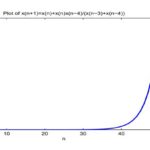
Theorem 9. Let \(\{x_n\}_{n=-4}^\infty\) be a solution of Equation (7). Then for \(n=0,1,2,…\) \begin{equation*} \left\{ \begin{array}{llll} \displaystyle x_{8n-4}=\dfrac{r^{n}}{e^{n-1}}\dfrac{(rfgh)^{n}}{ (-f+e)^{n}(-g+f)^{n}(-h+g)^{n}(-r+h)^{n}}, & & & \\ \displaystyle x_{8n-3}=f\dfrac{r^{n}}{e^{n}}\dfrac{(rfgh)^{n}}{ (-f+e)^{n}(-g+f)^{n}(-h+g)^{n}(-r+h)^{n}}, & & & \\ \displaystyle x_{8n-2}=g\dfrac{r^{n}}{e^{n}}\dfrac{(rfgh)^{n}}{ (-f+e)^{n}(-g+f)^{n}(-h+g)^{n}(-r+h)^{n}}, & & & \\ \displaystyle x_{8n-1}=h\dfrac{r^{n}}{e^{n}}\dfrac{(rfgh)^{n}}{ (-f+e)^{n}(-g+f)^{n}(-h+g)^{n}(-r+h)^{n}}, & & & \\ \displaystyle x_{8n}=\dfrac{r^{n+1}}{e^n}\dfrac{(rfgh)^{n}}{ (-f+e)^{n}(-g+f)^{n}(-h+g)^{n}(-r+h)^{n}}, & & & \\ \displaystyle x_{8n+1}=-f\dfrac{r^{n+1}}{e^n}\dfrac{(rfgh)^{n}}{ (-f+e)^{n+1}(-g+f)^{n}(-h+g)^{n}(-r+h)^{n}}, & & & \\ \displaystyle x_{8n+2}=fg\dfrac{r^{n+1}}{e^n}\dfrac{(rfgh)^{n}}{ (-f+e)^{n+1}(-g+f)^{n+1}(-h+g)^{n}(-r+h)^{n}}, & & & \\ \displaystyle x_{8n+3}=-fgh\dfrac{r^{n+1}}{e^n}\dfrac{(rfgh)^{n}}{ (-f+e)^{n+1}(-g+f)^{n+1}(-h+g)^{n+1}(-r+h)^{n}}. & & & \end{array} \right. \end{equation*}
Proof. For \(n=0\), the result holds. Now suppose that our assumption holds for \(n-1\). That is \begin{equation*} \left\{ \begin{array}{llll} \displaystyle x_{8n-12}=\dfrac{r^{n-1}}{e^{n-2}}\dfrac{(rfgh)^{n-1}}{ (-f+e)^{n-1}(-g+f)^{n-1}(-h+g)^{n-1}(-r+h)^{n-1}}, & & & \\ \displaystyle x_{8n-11}=f\dfrac{r^{n-1}}{e^{n-1}}\dfrac{(rfgh)^{n-1}}{ (-f+e)^{n-1}(-g+f)^{n-1}(-h+g)^{n-1}(-r+h)^{n-1}}, & & & \\ \displaystyle x_{8n-10}=g\dfrac{r^{n-1}}{e^{n-1}}\dfrac{(rfgh)^{n-1}}{ (-f+e)^{n-1}(-g+f)^{n-1}(-h+g)^{n-1}(-r+h)^{n-1}}, & & & \\ \displaystyle x_{8n-9}=h\dfrac{r^{n-1}}{e^{n-1}}\dfrac{(rfgh)^{n-1}}{ (-f+e)^{n-1}(-g+f)^{n-1}(-h+g)^{n-1}(-r+h)^{n-1}}, & & & \\ \displaystyle x_{8n-8}=\dfrac{r^{n}}{e^{n-1}}\dfrac{(rfgh)^{n-1}}{ (-f+e)^{n-1}(-g+f)^{n-1}(-h+g)^{n-1}(-r+h)^{n-1}}, & & & \\ \displaystyle x_{8n-7}=-f\dfrac{r^{n}}{e^{n-1}}\dfrac{(rfgh)^{n-1}}{ (-f+e)^{n}(-g+f)^{n-1}(-h+g)^{n-1}(-r+h)^{n-1}}, & & & \\ \displaystyle x_{8n-6}=fg\dfrac{r^{n}}{e^{n-1}}\dfrac{(rfgh)^{n-1}}{ (-f+e)^{n}(-g+f)^{n}(-h+g)^{n-1}(-r+h)^{n-1}}, & & & \\ \displaystyle x_{8n-5}=-fgh\dfrac{r^{n}}{e^{n-1}}\dfrac{(rfgh)^{n-1}}{ (-f+e)^{n}(-g+f)^{n}(-h+g)^{n}(-r+h)^{n-1}}. & & & \end{array} \right. \end{equation*} Now it follows from Equation (7) that \begin{equation*} \begin{array}{llll} \displaystyle x_{8n}=\displaystyle x_{8n-1}+\dfrac{ x_{8n-1} x_{8n-5}}{ x_{8n-4}-x_{8n-5}}= h\dfrac{r^{n}}{e^{n}}\dfrac{(rfgh)^{n}}{ (-f+e)^{n}(-g+f)^{n}(-h+g)^{n}(-r+h)^{n}} & & & \\ \left(1+\dfrac{-fgh\dfrac{r^{n}}{e^{n-1}}\dfrac{(rfgh)^{n-1}}{ (-f+e)^{n}(-g+f)^{n}(-h+g)^{n}(-r+h)^{n-1}}}{\dfrac{r^{n}}{e^{n-1}}\dfrac{ (rfgh)^{n}}{(-f+e)^{n}(-g+f)^{n}(-h+g)^{n}(-r+h)^{n}}+fgh\dfrac{r^{n}}{ e^{n-1}}\dfrac{(rfgh)^{n-1}}{(-f+e)^{n}(-g+f)^{n}(-h+g)^{n}(-r+h)^{n-1}}} \right) & & & \\ =\displaystyle h\dfrac{r^{n}}{e^{n}}\dfrac{(rfgh)^{n}}{ (-f+e)^{n}(-g+f)^{n}(-h+g)^{n}(-r+h)^{n}} \left(1+\dfrac{-1}{\dfrac{r}{(-r+h) }+1}\right) \\ =\displaystyle h\dfrac{r^{n}}{e^{n}}\dfrac{(rfgh)^{n}}{ (-f+e)^{n}(-g+f)^{n}(-h+g)^{n}(-r+h)^{n}} \left(1+\dfrac{r-h}{h}\right) & & & \\ =\displaystyle h\dfrac{r^{n}}{e^{n}}\dfrac{(rfgh)^{n}}{ (-f+e)^{n}(-g+f)^{n}(-h+g)^{n}(-r+h)^{n}} \dfrac{r}{h}\\ =\displaystyle \dfrac{ r^{n+1}}{e^{n}}\dfrac{(rfgh)^{n}}{(-f+e)^{n}(-g+f)^{n}(-h+g)^{n}(-r+h)^{n}} & & & \end{array} \end{equation*} Similarly, \begin{equation*} \begin{array}{llll} \displaystyle x_{8n+1}=\displaystyle x_{8n}+\dfrac{ x_{8n} x_{8n-4}}{ x_{8n-3}-x_{8n-4}}\\ = \dfrac{r^{n+1}}{e^{n}}\dfrac{(rfgh)^{n}}{ (-f+e)^{n}(-g+f)^{n}(-h+g)^{n}(-r+h)^{n}} & & & \\ \left(1+\dfrac{\dfrac{r^{n}}{e^{n-1}}\dfrac{(rfgh)^{n}}{ (-f+e)^{n}(-g+f)^{n}(-h+g)^{n}(-r+h)^{n}}}{f\dfrac{r^{n}}{e^{n}}\dfrac{ (rfgh)^{n}}{(-f+e)^{n}(-g+f)^{n}(-h+g)^{n}(-r+h)^{n}}-\dfrac{r^{n}}{e^{n-1}} \dfrac{(rfgh)^{n}}{(-f+e)^{n}(-g+f)^{n}(-h+g)^{n}(-r+h)^{n}}}\right) & & & \\ =\displaystyle \dfrac{r^{n+1}}{e^{n}}\dfrac{(rfgh)^{n}}{ (-f+e)^{n}(-g+f)^{n}(-h+g)^{n}(-r+h)^{n}} \left(1+\dfrac{1}{\dfrac{f}{e}-1} \right)\\ =\displaystyle \dfrac{r^{n+1}}{e^{n}}\dfrac{(rfgh)^{n}}{ (-f+e)^{n}(-g+f)^{n}(-h+g)^{n}(-r+h)^{n}} \left(1+\dfrac{e}{f-e}\right) & & & \\ =\displaystyle \dfrac{r^{n+1}}{e^{n}}\dfrac{(rfgh)^{n}}{ (-f+e)^{n}(-g+f)^{n}(-h+g)^{n}(-r+h)^{n}} \dfrac{f}{f-e}\\ =\displaystyle -f \dfrac{r^{n+1}}{e^{n}}\dfrac{(rfgh)^{n}}{ (-f+e)^{n+1}(-g+f)^{n}(-h+g)^{n}(-r+h)^{n}} & & & \end{array} \end{equation*} Similarly, one can easily obtain the other relations. Thus, the proof is completed.
Consider numerical examples which represent different types of solutions to Equation (7).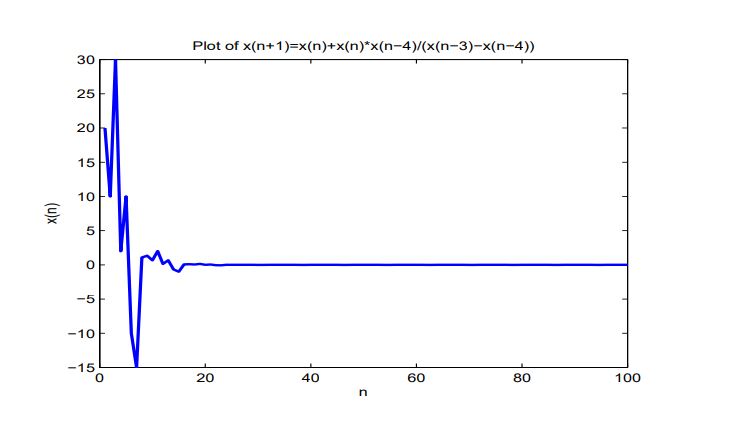
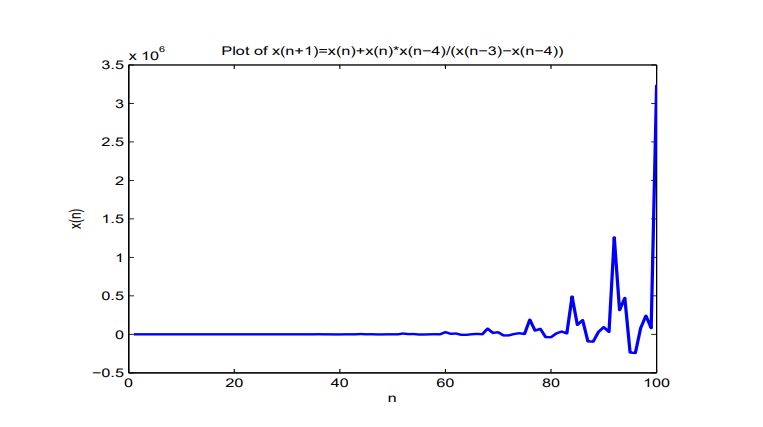
Theorem 10. Let \(\{x_n\}_{n=-4}^\infty\) be a solution of Equation (8). Then for \(n=0,1,2,…\) \begin{equation*} \left\{ \begin{array}{llll} \displaystyle x_{4n} & = & \dfrac{ r\;(rfgh)^n}{\displaystyle \prod_{i=1}^{n}(if+e)(ig+f)(ih+g)(ir+h)}, & \\ \displaystyle x_{4n+1} & = & \dfrac{ rf\;(rfgh)^n}{\displaystyle \prod_{i=1}^{n+1}(if+e)\prod_{i=1}^{n}(ig+f)(ih+g)(ir+h)}, & \\ \displaystyle x_{4n+2} & = & \dfrac{ rfg\;(rfgh)^n}{\displaystyle \prod_{i=1}^{n+1}(if+e)(ig+f)\prod_{i=1}^{n}(ih+g)(ir+h)}, & \\ \displaystyle x_{4n+3} & = & \dfrac{ (rfgh)^{n+1}}{\displaystyle \prod_{i=1}^{n+1}(if+e)(ig+f)(ih+g)\prod_{i=1}^{n}(ir+h)}. & \end{array} \right. \end{equation*}
Proof. For \(n=0\), the result holds. Now suppose that our assumption holds for \(n-1\) and for \(n-2\). That is \begin{equation*} \left\{ \begin{array}{llll} \displaystyle x_{4n-4} = \dfrac{ r\;(rfgh)^{n-1}}{\displaystyle \prod_{i=1}^{n-1}(if+e)(ig+f)(ih+g)(ir+h)}, & \\ \displaystyle x_{4n-3} = \dfrac{ rf\;(rfgh)^{n-1}}{\displaystyle \prod_{i=1}^{n}(if+e)\prod_{i=1}^{n-1}(ig+f)(ih+g)(ir+h)}, & \\ \displaystyle x_{4n-2} = \dfrac{ rfg\;(rfgh)^{n-1}}{\displaystyle \prod_{i=1}^{n}(if+e)(ig+f)\prod_{i=1}^{n-1}(ih+g)(ir+h)}, & \\ \displaystyle x_{4n-1} = \dfrac{ (rfgh)^{n}}{\displaystyle \prod_{i=1}^{n}(if+e)(ig+f)(ih+g)\prod_{i=1}^{n-1}(ir+h)}, & \end{array} \right. \left\{ \begin{array}{llll} \displaystyle x_{4n-8} = \dfrac{ r\;(rfgh)^{n-2}}{\displaystyle \prod_{i=1}^{n-2}(if+e)(ig+f)(ih+g)(ir+h)}, & \\ \displaystyle x_{4n-7} = \dfrac{ rf\;(rfgh)^{n-2}}{\displaystyle \prod_{i=1}^{n-1}(if+e)\prod_{i=1}^{n-2}(ig+f)(ih+g)(ir+h)}, & \\ \displaystyle x_{4n-6} = \dfrac{ rfg\;(rfgh)^{n-2}}{\displaystyle \prod_{i=1}^{n-1}(if+e)(ig+f)\prod_{i=1}^{n-2}(ih+g)(ir+h)}, & \\ \displaystyle x_{4n-5} = \dfrac{ (rfgh)^{n-1}}{\displaystyle \prod_{i=1}^{n-1}(if+e)(ig+f)(ih+g)\prod_{i=1}^{n-2}(ir+h)}. & \end{array} \right. \end{equation*} Now it follows from Equation (8) that \begin{equation*} \begin{array}{llll} \displaystyle x_{4n}=x_{4n-1}-\dfrac{ x_{4n-1} x_{4n-5}}{ x_{4n-4}+x_{4n-5}} = \dfrac{ (rfgh)^{n}}{\displaystyle \prod_{i=1}^{n}(if+e)(ig+f)(ih+g) \prod_{i=1}^{n-1}(ir+h)} & & & \\ \left(1-\dfrac{\dfrac{ (rfgh)^{n-1}}{\displaystyle \prod_{i=1}^{n-1}(if+e)(ig+f)(ih+g)\prod_{i=1}^{n-2}(ir+h)}}{\dfrac{ r\;(rfgh)^{n-1}}{\displaystyle \prod_{i=1}^{n-1}(if+e)(ig+f)(ih+g)(ir+h)} + \dfrac{ (rfgh)^{n-1}}{\displaystyle \prod_{i=1}^{n-1}(if+e)(ig+f)(ih+g) \prod_{i=1}^{n-2}(ir+h)}} \right) & & & \\ \end{array} \end{equation*} \begin{equation*} \begin{array}{llll}\displaystyle = \dfrac{ (rfgh)^{n}}{\displaystyle \prod_{i=1}^{n}(if+e)(ig+f)(ih+g)\prod_{i=1}^{n-1}(ir+h)} \left(1-\dfrac{1}{ \dfrac{ r}{(n-1)r+h} + 1} \right)\\ \displaystyle = \dfrac{ (rfgh)^{n}}{ \displaystyle \prod_{i=1}^{n}(if+e)(ig+f)(ih+g)\prod_{i=1}^{n-1}(ir+h)} \left(1-\dfrac{(n-1)r+h}{nr+h} \right) & & & \\ \displaystyle = \dfrac{ (rfgh)^{n}}{\displaystyle \prod_{i=1}^{n}(if+e)(ig+f)(ih+g)\prod_{i=1}^{n-1}(ir+h)} \left(\dfrac{r}{ nr+h} \right) \\ \displaystyle = \dfrac{ r(rfgh)^{n}}{\displaystyle \prod_{i=1}^{n}(if+e)(ig+f)(ih+g)(ir+h)} . & & & \\ \end{array} \end{equation*} Similarly, \begin{equation*} \begin{array}{llll} \displaystyle x_{4n+1}=x_{4n}-\dfrac{ x_{4n} x_{4n-4}}{ x_{4n-3}+x_{4n-4}}= \dfrac{ r(rfgh)^{n}}{\displaystyle \prod_{i=1}^{n}(if+e)(ig+f)(ih+g)(ir+h)} & & & \\ \left(1-\dfrac{\dfrac{ r(rfgh)^{n-1}}{\displaystyle \prod_{i=1}^{n-1}(if+e)(ig+f)(ih+g)(ir+h)}}{\dfrac{ rf\;(rfgh)^{n-1}}{ \displaystyle \prod_{i=1}^{n}(if+e)\prod_{i=1}^{n-1}(ig+f)(ih+g)(ir+h)} + \dfrac{ r(rfgh)^{n-1}}{\displaystyle \prod_{i=1}^{n-1}(if+e)(ig+f)(ih+g)(ir+h)}} \right) & & & \\ \end{array} \end{equation*} \begin{equation*} \begin{array}{llll} \displaystyle = \dfrac{r (rfgh)^{n}}{\displaystyle \prod_{i=1}^{n}(if+e)(ig+f)(ih+g)(ir+h)} \left(1-\dfrac{1}{\dfrac{ f}{nf+e} + 1} \right) \\ \displaystyle = \dfrac{ r(rfgh)^{n}}{\displaystyle \prod_{i=1}^{n}(if+e)(ig+f)(ih+g)(ir+h)} \left(1-\dfrac{nf+e}{(n+1)f+e} \right) & & & \\ \displaystyle = \dfrac{ r(rfgh)^{n}}{\displaystyle \prod_{i=1}^{n}(if+e)(ig+f)(ih+g)(ir+h)} \left(\dfrac{f}{(n+1)f+e} \right) \\ \displaystyle = \dfrac{ r(rfgh)^{n}}{\displaystyle \prod_{i=1}^{n+1}(if+e) \prod_{i=1}^{n}(ig+f)(ih+g)(ir+h)} . & & & \end{array} \end{equation*} Similarly, one can easily obtain the other relations. Thus, the proof is completed.
Consider numerical examples which represent different types of solutions to Equation (8).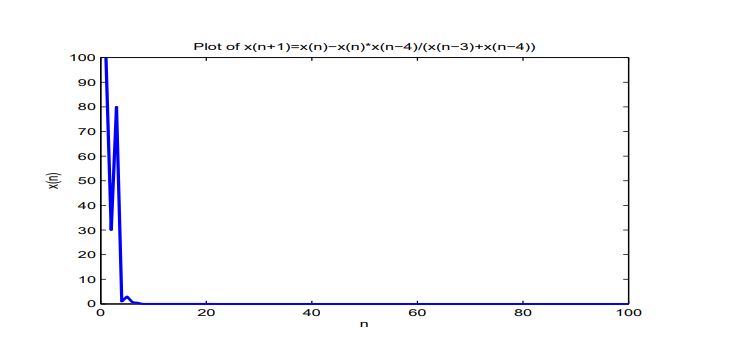
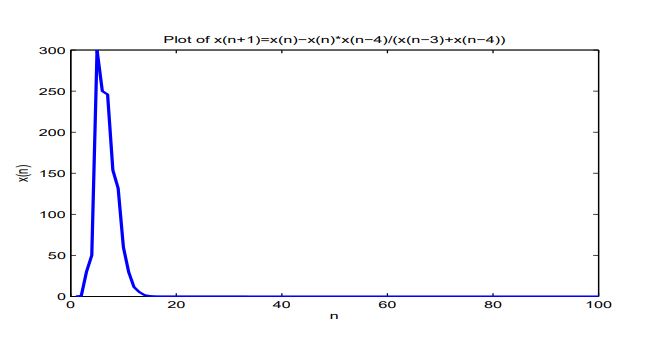
Theorem 11. Let \(\{x_n\}_{n=-4}^\infty\) be a solution of Equation (9). Then for \(n=0,1,2,…\) \begin{equation*} \left\{ \begin{array}{llll} \displaystyle x_{8n-4}=\dfrac{r^{n}}{e^{n-1}}\dfrac{ (-f+2e)^{n}(-g+2f)^{n}(-h+2g)^{n}(-r+2h)^{n}}{ (-f+e)^{n}(-g+f)^{n}(-h+g)^{n}(-r+h)^{n}}, & & & \\ \displaystyle x_{8n-3}=f\dfrac{r^{n}}{e^{n}}\dfrac{ (-f+2e)^{n}(-g+2f)^{n}(-h+2g)^{n}(-r+2h)^{n}}{ (-f+e)^{n}(-g+f)^{n}(-h+g)^{n}(-r+h)^{n}}, & & & \\ \displaystyle x_{8n-2}=g\dfrac{r^{n}}{e^{n}}\dfrac{ (-f+2e)^{n}(-g+2f)^{n}(-h+2g)^{n}(-r+2h)^{n}}{ (-f+e)^{n}(-g+f)^{n}(-h+g)^{n}(-r+h)^{n}}, & & & \\ \displaystyle x_{8n-1}=h\dfrac{r^{n}}{e^{n}}\dfrac{ (-f+2e)^{n}(-g+2f)^{n}(-h+2g)^{n}(-r+2h)^{n}}{ (-f+e)^{n}(-g+f)^{n}(-h+g)^{n}(-r+h)^{n}}, & & & \\ \displaystyle x_{8n}=\dfrac{r^{n+1}}{e^n}\dfrac{ (-f+2e)^{n}(-g+2f)^{n}(-h+2g)^{n}(-r+2h)^{n}}{ (-f+e)^{n}(-g+f)^{n}(-h+g)^{n}(-r+h)^{n}} , & & & \\ \displaystyle x_{8n+1}=\dfrac{r^{n+1}}{e^n}\dfrac{ (-f+2e)^{n+1}(-g+2f)^{n}(-h+2g)^{n}(-r+2h)^{n}}{ (-f+e)^{n+1}(-g+f)^{n}(-h+g)^{n}(-r+h)^{n}}, & & & \\ \displaystyle x_{8n+2}=\dfrac{r^{n+1}}{e^n}\dfrac{ (-f+2e)^{n+1}(-g+2f)^{n+1}(-h+2g)^{n}(-r+2h)^{n}}{ (-f+e)^{n+1}(-g+f)^{n+1}(-h+g)^{n}(-r+h)^{n}}, & & & \\ \displaystyle x_{8n+3}=\dfrac{r^{n+1}}{e^n}\dfrac{ (-f+2e)^{n+1}(-g+2f)^{n+1}(-h+2g)^{n+1}(-r+2h)^{n}}{ (-f+e)^{n+1}(-g+f)^{n+1}(-h+g)^{n+1}(-r+h)^{n}}. & & & \end{array} \right. \end{equation*}
Proof. For \(n=0\), the result holds. Now suppose that our assumption holds for \(n-1\). That is \begin{equation*} \left\{ \begin{array}{llll} \displaystyle x_{8n-12}=\dfrac{r^{n-1}}{e^{n-2}}\dfrac{ (-f+2e)^{n-1}(-g+2f)^{n-1}(-h+2g)^{n-1}(-r+2h)^{n-1}}{ (-f+e)^{n-1}(-g+f)^{n-1}(-h+g)^{n-1}(-r+h)^{n-1}}, & & & \\ \displaystyle x_{8n-11}=f\dfrac{r^{n-1}}{e^{n-1}}\dfrac{ (-f+2e)^{n-1}(-g+2f)^{n-1}(-h+2g)^{n-1}(-r+2h)^{n-1}}{ (-f+e)^{n-1}(-g+f)^{n-1}(-h+g)^{n-1}(-r+h)^{n-1}}, & & & \\ \displaystyle x_{8n-10}=g\dfrac{r^{n-1}}{e^{n-1}}\dfrac{ (-f+2e)^{n-1}(-g+2f)^{n-1}(-h+2g)^{n-1}(-r+2h)^{n-1}}{ (-f+e)^{n-1}(-g+f)^{n-1}(-h+g)^{n-1}(-r+h)^{n-1}}, & & & \\ \displaystyle x_{8n-9}=h\dfrac{r^{n-1}}{e^{n-1}}\dfrac{ (-f+2e)^{n-1}(-g+2f)^{n-1}(-h+2g)^{n-1}(-r+2h)^{n-1}}{ (-f+e)^{n-1}(-g+f)^{n-1}(-h+g)^{n-1}(-r+h)^{n-1}}, & & & \\ \displaystyle x_{8n-8}=\dfrac{r^{n}}{e^{n-1}}\dfrac{ (-f+2e)^{n-1}(-g+2f)^{n-1}(-h+2g)^{n-1}(-r+2h)^{n-1}}{ (-f+e)^{n-1}(-g+f)^{n-1}(-h+g)^{n-1}(-r+h)^{n-1}} , & & & \\ \displaystyle x_{8n-7}=\dfrac{r^{n}}{e^{n-1}}\dfrac{ (-f+2e)^{n}(-g+2f)^{n-1}(-h+2g)^{n-1}(-r+2h)^{n-1}}{ (-f+e)^{n}(-g+f)^{n-1}(-h+g)^{n-1}(-r+h)^{n-1}}, & & & \\ \displaystyle x_{8n-6}=\dfrac{r^{n}}{e^{n-1}}\dfrac{ (-f+2e)^{n}(-g+2f)^{n}(-h+2g)^{n-1}(-r+2h)^{n-1}}{ (-f+e)^{n}(-g+f)^{n}(-h+g)^{n-1}(-r+h)^{n-1}}, & & & \\ \displaystyle x_{8n-5}=\dfrac{r^{n}}{e^{n-1}}\dfrac{ (-f+2e)^{n}(-g+2f)^{n}(-h+2g)^{n}(-r+2h)^{n-1}}{ (-f+e)^{n}(-g+f)^{n}(-h+g)^{n}(-r+h)^{n-1}}. & & & \end{array} \right. \end{equation*} Now it follows from Equation (9) that \begin{equation*} \begin{array}{llll} \displaystyle x_{8n}=x_{8n-1}+\dfrac{ x_{8n-1} x_{8n-5}}{-x_{8n-4}+x_{8n-5}} & & & \\ = h\dfrac{r^{n}}{e^{n}}\dfrac{(-f+2e)^{n}(-g+2f)^{n}(-h+2g)^{n}(-r+2h)^{n}}{ (-f+e)^{n}(-g+f)^{n}(-h+g)^{n}(-r+h)^{n}} & & & \\ \left(1+ \dfrac{\dfrac{r^{n}}{e^{n-1}}\dfrac{ (-f+2e)^{n}(-g+2f)^{n}(-h+2g)^{n}(-r+2h)^{n-1}}{ (-f+e)^{n}(-g+f)^{n}(-h+g)^{n}(-r+h)^{n-1}}}{-\dfrac{r^{n}}{e^{n-1}}\dfrac{ (-f+2e)^{n}(-g+2f)^{n}(-h+2g)^{n}(-r+2h)^{n}}{ (-f+e)^{n}(-g+f)^{n}(-h+g)^{n}(-r+h)^{n}}+\dfrac{r^{n}}{e^{n-1}}\dfrac{ (-f+2e)^{n}(-g+2f)^{n}(-h+2g)^{n}(-r+2h)^{n-1}}{ (-f+e)^{n}(-g+f)^{n}(-h+g)^{n}(-r+h)^{n-1}} }\right ) \\ \displaystyle = h \dfrac{r^{n}}{e^{n}}\dfrac{(-f+2e)^{n}(-g+2f)^{n}(-h+2g)^{n}(-r+2h)^{n}}{ (-f+e)^{n}(-g+f)^{n}(-h+g)^{n}(-r+h)^{n}} \left(1+ \dfrac{1}{-\dfrac{(-r+2h) }{(-r+h)}+1 }\right ) \\ \displaystyle = h\dfrac{r^{n}}{e^{n}}\dfrac{ (-f+2e)^{n}(-g+2f)^{n}(-h+2g)^{n}(-r+2h)^{n}}{ (-f+e)^{n}(-g+f)^{n}(-h+g)^{n}(-r+h)^{n}} \left(1+ \dfrac{(-r+h)}{-h}\right )\\ \displaystyle = h\dfrac{r^{n}}{e^{n}}\dfrac{ (-f+2e)^{n}(-g+2f)^{n}(-h+2g)^{n}(-r+2h)^{n}}{ (-f+e)^{n}(-g+f)^{n}(-h+g)^{n}(-r+h)^{n}} \left(\dfrac{r}{h}\right ) \\ \displaystyle = \dfrac{r^{n+1}}{e^{n}}\dfrac{ (-f+2e)^{n}(-g+2f)^{n}(-h+2g)^{n}(-r+2h)^{n}}{ (-f+e)^{n}(-g+f)^{n}(-h+g)^{n}(-r+h)^{n}}. \\ & & & \\ \displaystyle = h\dfrac{r^{n}}{e^{n}}\dfrac{ (-f+2e)^{n}(-g+2f)^{n}(-h+2g)^{n}(-r+2h)^{n}}{ (-f+e)^{n}(-g+f)^{n}(-h+g)^{n}(-r+h)^{n}} \left(1+ \dfrac{1}{-\dfrac{(-r+2h) }{(-r+h)}+1 }\right ) & & & \\ \displaystyle = h\dfrac{r^{n}}{e^{n}}\dfrac{ (-f+2e)^{n}(-g+2f)^{n}(-h+2g)^{n}(-r+2h)^{n}}{ (-f+e)^{n}(-g+f)^{n}(-h+g)^{n}(-r+h)^{n}} \left(1+ \dfrac{(-r+h)}{-h}\right )\\ \displaystyle = h\dfrac{r^{n}}{e^{n}}\dfrac{ (-f+2e)^{n}(-g+2f)^{n}(-h+2g)^{n}(-r+2h)^{n}}{ (-f+e)^{n}(-g+f)^{n}(-h+g)^{n}(-r+h)^{n}} \left(\dfrac{r}{h}\right ) & & & \\ \displaystyle = \dfrac{r^{n+1}}{e^{n}}\dfrac{ (-f+2e)^{n}(-g+2f)^{n}(-h+2g)^{n}(-r+2h)^{n}}{ (-f+e)^{n}(-g+f)^{n}(-h+g)^{n}(-r+h)^{n}}. & & & \end{array} \end{equation*} Similarly, \begin{equation*} \begin{array}{llll} \displaystyle x_{8n+1}=x_{8n}+\dfrac{ x_{8n} x_{8n-4}}{-x_{8n-3}+x_{8n-4}} = \dfrac{r^{n+1}}{e^{n}}\dfrac{(-f+2e)^{n}(-g+2f)^{n}(-h+2g)^{n}(-r+2h)^{n}}{ (-f+e)^{n}(-g+f)^{n}(-h+g)^{n}(-r+h)^{n}} & & & \\ \end{array} \end{equation*} \begin{equation*} \begin{array}{llll} \left(1+ \dfrac{\dfrac{r^{n}}{e^{n-1}}\dfrac{ (-f+2e)^{n}(-g+2f)^{n}(-h+2g)^{n}(-r+2h)^{n}}{ (-f+e)^{n}(-g+f)^{n}(-h+g)^{n}(-r+h)^{n}}}{-f\dfrac{r^{n}}{e^{n}}\dfrac{ (-f+2e)^{n}(-g+2f)^{n}(-h+2g)^{n}(-r+2h)^{n}}{ (-f+e)^{n}(-g+f)^{n}(-h+g)^{n}(-r+h)^{n}}+\dfrac{r^{n}}{e^{n-1}}\dfrac{ (-f+2e)^{n}(-g+2f)^{n}(-h+2g)^{n}(-r+2h)^{n}}{ (-f+e)^{n}(-g+f)^{n}(-h+g)^{n}(-r+h)^{n}} }\right ) \\ \displaystyle = \dfrac{ r^{n+1}}{e^{n}}\dfrac{(-f+2e)^{n}(-g+2f)^{n}(-h+2g)^{n}(-r+2h)^{n}}{ (-f+e)^{n}(-g+f)^{n}(-h+g)^{n}(-r+h)^{n}} \left(1+ \dfrac{1}{-\dfrac{f}{e}+1 }\right ) \\ \displaystyle = \dfrac{r^{n+1}}{e^{n}}\dfrac{ (-f+2e)^{n}(-g+2f)^{n}(-h+2g)^{n}(-r+2h)^{n}}{ (-f+e)^{n}(-g+f)^{n}(-h+g)^{n}(-r+h)^{n}} \left(1+ \dfrac{e}{-f+e}\right ) \\ \displaystyle = \dfrac{r^{n+1}}{e^{n}}\dfrac{ (-f+2e)^{n}(-g+2f)^{n}(-h+2g)^{n}(-r+2h)^{n}}{ (-f+e)^{n}(-g+f)^{n}(-h+g)^{n}(-r+h)^{n}} \left(\dfrac{-f+2e}{-f+e}\right ) \\ \displaystyle = \dfrac{r^{n+1}}{e^{n}}\dfrac{ (-f+2e)^{n+1}(-g+2f)^{n}(-h+2g)^{n}(-r+2h)^{n}}{ (-f+e)^{n+1}(-g+f)^{n}(-h+g)^{n}(-r+h)^{n}}\\ \displaystyle = \dfrac{r^{n+1}}{e^{n}}\dfrac{ (-f+2e)^{n}(-g+2f)^{n}(-h+2g)^{n}(-r+2h)^{n}}{ (-f+e)^{n}(-g+f)^{n}(-h+g)^{n}(-r+h)^{n}} \left(1+ \dfrac{1}{-\dfrac{f}{e}+1 }\right )\\ \displaystyle = \dfrac{r^{n+1}}{e^{n}}\dfrac{ (-f+2e)^{n}(-g+2f)^{n}(-h+2g)^{n}(-r+2h)^{n}}{ (-f+e)^{n}(-g+f)^{n}(-h+g)^{n}(-r+h)^{n}} \left(1+ \dfrac{e}{-f+e}\right ) & & & \\ \displaystyle = \dfrac{r^{n+1}}{e^{n}}\dfrac{ (-f+2e)^{n}(-g+2f)^{n}(-h+2g)^{n}(-r+2h)^{n}}{ (-f+e)^{n}(-g+f)^{n}(-h+g)^{n}(-r+h)^{n}} \left(\dfrac{-f+2e}{-f+e}\right ) \\ \displaystyle = \dfrac{r^{n+1}}{e^{n}}\dfrac{ (-f+2e)^{n+1}(-g+2f)^{n}(-h+2g)^{n}(-r+2h)^{n}}{ (-f+e)^{n+1}(-g+f)^{n}(-h+g)^{n}(-r+h)^{n}}. & & & \end{array} \end{equation*} Similarly, one can easily obtain the other relations. Thus, the proof is completed.
Consider numerical examples which represent different types of solutions to Equation (9).
